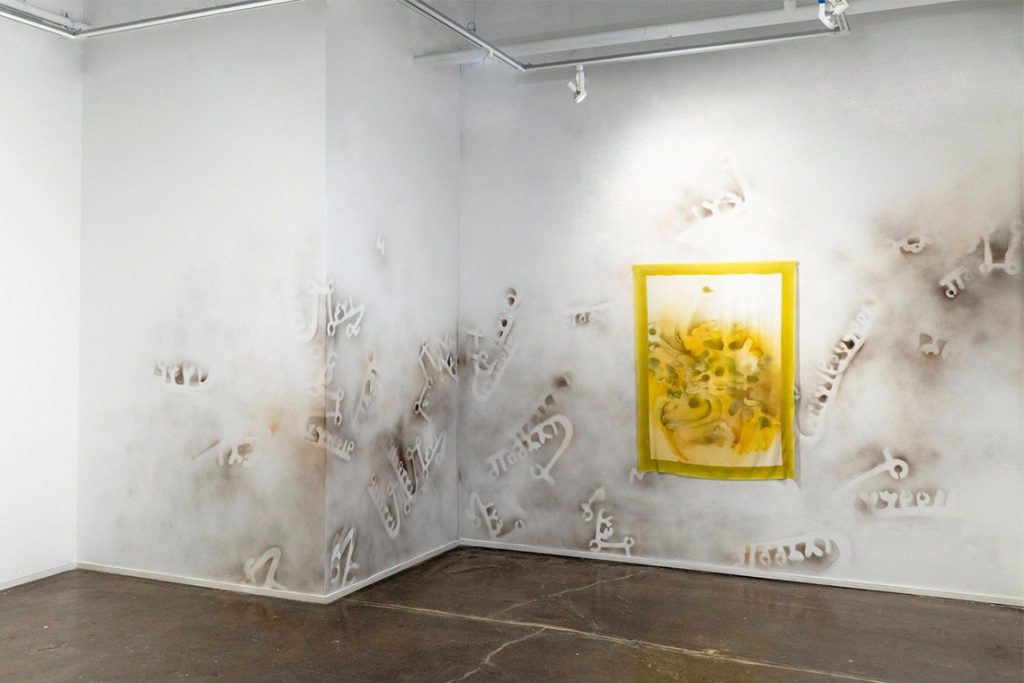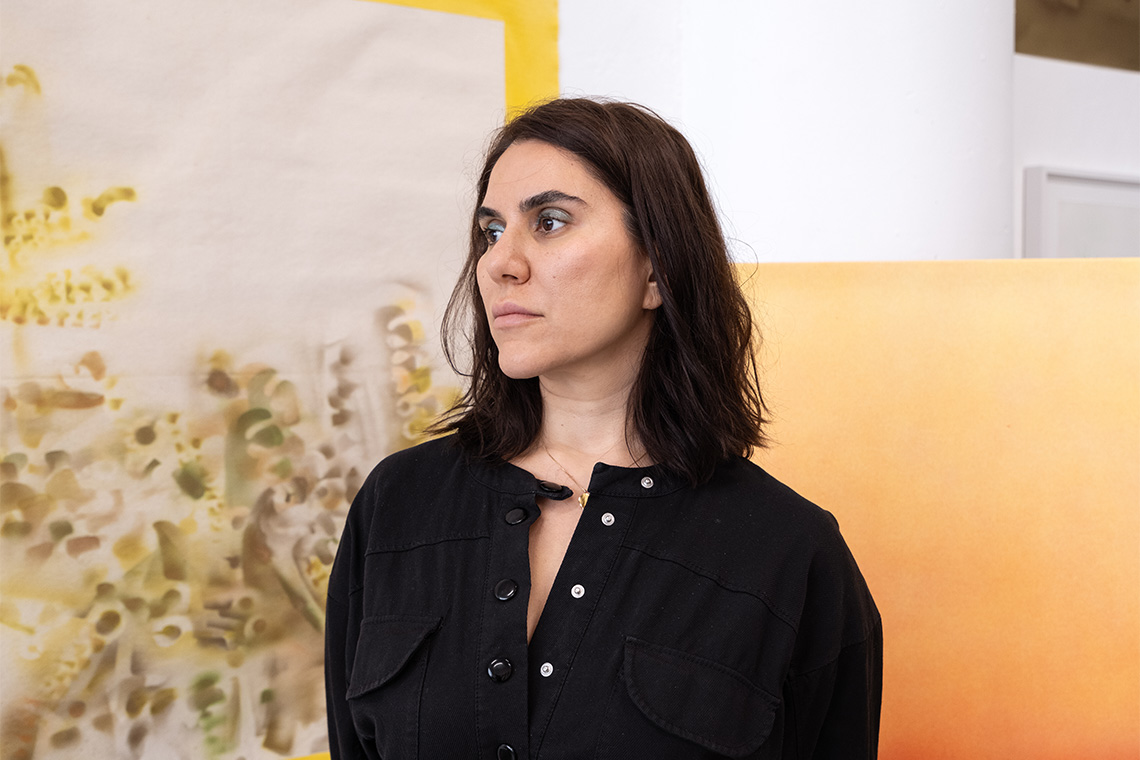Accessing unknown worlds and researching new means of visual perception through the building blocks of language is the basis of the artist’s practice.
Canvas: The occult is a particular focus of your artistic research. How did you first become interested in it?
Maryam Taghavi: In the past few years, I have begun to more consciously understand my fascination with elements of the unseen. Throughout history people have developed relationships to what is not visible, and have found ways to channel that power through various ceremonies, texts and rituals. I’m interested in those things that we can’t necessarily articulate but which we can feel. Recently I have been researching talismans and the occult, since in Iranian culture, especially growing up in the 1980s, there were always objects like this around you, such as bowls covered in scripts meant to channel certain powers, or with words of some protective quality.
What is the relationship between these talismans and language?
My research into talismanic texts looks at them not as texts that function in the typical way of making meaning, but rather as something performative that promises wish fulfilment via their forms alone. Sometimes talismanic texts become so abstracted that they are illegible, at which point they become sigils or symbols, more like codes that can mediate our relationship to the invisible world.
I’m quite fixated on taking elements like letter forms and numbers, and using them to make non-linguistic experiences. Numbers, for example, have been filled with mystery and meaning across every society.
Sigils are always tied into kinds of ceremony or ritual, but I am mostly fascinated with their formal properties. What I do in my art is contrary to their intended circulation. These are things that are meant to be concealed. You’re not supposed to announce a sigil through a painting and invite people to come see it. They are generally meant to be secretive processes.
How do you channel these powers through your artistic practice?
Replicating these sigils is a departure point for me. In a 2021 exhibition called A Form By Which To Be Possessed I used a single sigil that promised flight. This is an impossible ask, but the question of flight was very much present for me when I was making those paintings. I was thinking about suspension, about ecstasy, about the promise of flight, and indeed the failure of flight. All of these questions became present as I was making these paintings.

Your current exhibition Chicago Works at MCA Chicago explores these ideas alongside visual elements that investigate the faculty of sight and its relation to meaning. How did you conceive the show?
When I talk about the seen and the unseen, my focus is the optical relationship that we have with the world around us. Optical encounters throughout the exhibition question firstly how our position in relation to an object changes how we view it, and secondly how this affects our own awareness of movement and presence in space.
The first piece is seen through a cut-out in the wall beside the exhibition text. If people notice it and peer in, they’ll see infinite reflections of a form called a noghte inside a prism. Because the prism is hidden inside the wall, with your eye right up against its aperture, it’s impossible to understand the size of the prism and it gives the illusion of infinite space. However, the prism is repeated throughout the exhibition in various forms that can be interacted with and seen as deconstructed. One is 2D, flat on the floor, and people tend to make very gestural movements through its reflections to make silhouettes on the wall. It is the same polished stainless steel that is used as the interior of all the prisms, so by revealing its materials, what appears as an infinite mystery at the start of the show becomes demystified.
What is a noghte and why is it important in your work?
The noghte is used as a diacritic in both Arabic and Persian languages to determine the pronunciation of letter forms. It’s the crucial element that produces sound. Throughout this exhibition it takes the shape of a diamond, because I am referring to its calligraphic form. The way reed pens are cut for calligraphy means drawing what would normally be a dot becomes a diamond. Noghtes are used in calligraphy as a unit against which the proportions of a letter form is measured; you could say, for example, this letter is five dots long and half a dot tall. However, similar to other linguistic elements in the exhibition, the noghte is not serving its intended literary function. I use noghtes to illustrate the importance of relational measurement, especially thinking of things not on the page. In large-scale paintings, for example, it begins to reference things that are not measurable.

Maryam Taghavi. Installation view of A Form By Which To Be Possessed at Chicago Artists Coalition, 2021. Airbrush on crêpe de chine. 106.6 x 165 cm. Image courtesy of the artist
What sorts of things are not measurable?
A lot of our feelings are not measurable. How much you miss something is not measurable. I might be x miles away from someone, but that doesn’t determine how far from them or how close to them I feel. I swim in Lake Michigan every morning (when it’s not freezing), and my sense of distance changes completely. It doesn’t matter which way you’re facing, your direction is framed as either towards the horizon or the shore. I could measure my position in the lake, but there’s no need. I have all this space to be in and take pleasure in that. Things that are not measurable are not always sad things, it’s about a certain kind of abundance. Inspired by this unlimited perception of space, my Horizon series features noghtes revaluating perspectives, sightlines and vanishing points associated with Western landscape painting.
How do noghtes, calligraphy and talismanic sigils all coalesce in the exhibition?
The show hinges on a final piece of calligraphic poetry, by the revered 13th-century Persian poet Saadi Shīrāzī, that I commissioned with all the noghtes removed. Their lack frames a certain kind of absence. The tension that comes from the contrast of this piece with the rest of the exhibition is very important to me, as the other pieces borrow so much from calligraphy but move in completely different directions. The poem is very popular, and the four verses depict a state of holding an image of your beloved in your mind’s eye, even when there is distance between you.
When the noghtes are missing it becomes more laborious to read the text, so you have to really slow down to figure out the form of the letters and then put them together. Some are harder than others to decode, especially as this poem is written in a style that repeats its forms many times and doesn’t even have a horizontal or vertical orientation. It’s not particularly easy to read, as with the noghtes removed all the clues are taken away and it operates more as an abstract sigil. Only a reader already familiar with the poem, having worked out the first three or four words, would be able to decode the rest of it. So it’s not just a matter of legibility, but also familiarity.
This interview first appeared in Canvas 112: Uncovered



